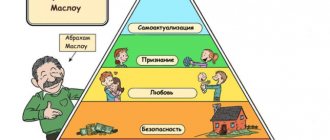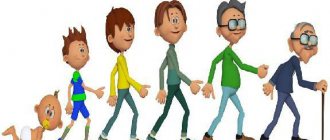Depending on the motives of the individual, a person performs certain actions. Behavior and activity are subject to a system of motives, which in turn are subject to the goals of the person himself. If a person does not have goals, then motives can be subordinated to emotions, fears, and complexes that arise in a short period of time. In other words, a person does not act just like that. Everything happens for a reason.
Many readers of the online magazine psytheater.com have encountered situations where they could not understand the motives of other people. At the same time, other people do not always understand the motives of a particular person. Quite often, a similar situation unfolds when a person who wants to understand does not want to accept the true reasons for actions. For example, a woman may not understand why a man broke up with her, while he himself argues for his behavior by the fading of feelings. The woman tries to find the hidden meaning of his words, to find the true reason, although the fading of feelings is enough for separation.
Motives lie in all human actions. Another question: does a person understand the motives of his behavior? Often people themselves do not understand why they acted in one way or another. However, nothing just happens. Behavior is the effect, and motive is the cause. If a person does not see any motive, this does not mean that it does not exist.
What are personal motives?
Personal motives have many definitions. The main one is internal strength, which motivates a person to take specific actions in order to achieve a certain result. But what is the motive itself?
- Some see it as an idea that a person implements.
- Others present it in the form of certain beliefs that guide a person when performing actions.
- Still others mean by it a certain surge of energy that occurs when there is a specific goal.
Motivation pushes a person to take action. If there is a motive, then a person has the energy that he needs to perform actions and achieve certain results. Quite often it is necessary to motivate employees at a company. Thus, managers create external motivational benefits that should interest their employees so much that they begin to take the actions the managers need. These external motives can be:
- Reward in cash equivalent.
- Promotion on the career ladder.
- Salary increase. Etc.
A motive is like a carrot in the face of a donkey, which must go in the direction that the one holding this carrot needs.
However, there is such a thing as internal motivation. And compared to the outside, the inside is much stronger. In other words, a person must “light up” internally so that he has enough energy to be able to “move mountains.” And external motivators have less impact.
go to top
Self-motivation
A person’s actions are stimulated by his desire or desire to improve his life position. In other words, a person can independently convince himself that it is necessary to act, even if something is not going well.
This process is individual, and a person can decide for himself how to motivate himself or use internal motivation. But there are also methods that have a positive effect on most people. Manipulators often and skillfully use such methods.
Motives of personality behavior
People have always been interested in the question “Why?” Why does another person perform this and not another action? How can you influence him? Is it possible to change another person's behavior? If at first a person is brought up, which is why certain motives, beliefs, views are laid in him, then he himself can control his behavior or obey internal messages, which will be his personal motives.
Until now, people ask the question “Why?”, the answer to which is that a person’s motives depend on the situation, external pressure, internal desires and goals, even the personal qualities of a person’s character.
Motives of behavior are not static. There are motives that lie deep in the subconscious. Usually a person does not pay attention to them. However, there are motives that a person can control. For example, goal setting is a motive that encourages a person to act towards achieving what he wants. However, it is also the person who sets the goal; in other words, he motivates himself.
The underlying motives of a person’s behavior can be called basic needs, which were considered by Abraham Maslow and presented in the form of a table:
- First of all, a person will take care of his life and physiology. He needs food, water, air, sex, physical health, etc.
- If the previous need is fully satisfied, then the person can take care of his own safety, which includes starting a family, improving the home, getting a job, health prevention, etc.
- Already at the third stage, after satisfying previous needs, a person engages in interpersonal relationships, since he is a social being who wants to love, make friends, communicate, receive emotions and give them himself.
- With the normalization of previous levels of needs, a person begins to develop a certain attitude towards himself: self-respect, recognition, approval, etc.
- Already at the last level of needs lie moral development, creativity, achievement of one’s own “I”, etc., that is, spiritual development. However, it is comprehended only when a person is satisfied with the previous 4 levels of his life.
Needs are the needs that a person needs in a specific period of time. Some needs are temporary, that is, they are satisfied quickly enough, others are periodic, that is, the need for them arises from time to time, and others are permanent, when a person must constantly satisfy them.
Needs can concern any object. They are also divided into individual and group. Usually a person has a desire to satisfy several needs at once. That is, he does not satisfy one need after another, but they arise in a complex, which is why the individual is often torn between the need to satisfy one or another need.
Based on Maslow's pyramid, it is clear that a person first of all needs physiological needs. And only after they are satisfied can he move on to achieving more spiritual needs.
go to top
Motivation, motives, personality needs
| Motivation occupies a special place in the structure of personality and is one of the main concepts used to explain the driving forces of human behavior and activity. The term “motivation” is derived from the word “motive” (from the Latin movere - to move). Consequently, a motive can be defined as something that forces one to be active, and a person’s motivation is understood as the whole complex of factors that encourage and direct human behavior. In modern psychology, “motivation” is used in a dual sense: as a system of factors that determine behavior (needs, motives, goals, intentions, aspirations, etc.), and as a characteristic of a process that stimulates and supports. Motive is defined as a stimulant (inducement) to any activity or behavior, that is, the motive acts as their cause . At the same time, a motive is also an objectified (“known”) need, that is, a material or ideal object for the sake of which activity is performed (Need is a state of need of an organism for something that lies outside of it and constitutes an objective condition of its existence. Need is considered as source of personality activity. Its main properties are objectivity, cyclicality (it is periodically updated and disappears) and dynamism (varies according to the strength of tension). There are various types of needs: for example, material, social and spiritual needs. Widely known and used in the process of stimulating personnel of organizations classification of needs, which includes physiological (basic) needs; the need for security and stability; the need for communication (contact with others like oneself); the need for respect and recognition of merit; the need for self-actualization and self-realization. The need as an internal force can only be realized in activity, and the need acquires its objectivity only in the situation of discovering its object, and the perceived (imagined, conceivable) object acquires its motivating and directing function, becoming a motive. A motive differs from a need in that it is primarily a directed activity (“vector” of activity). The main functions of motives are incentive (encourages the subject to activity), directing (determines the “vector” of activity), goal-forming (generates a “nest of goals”) and meaning-forming (the leading motive acquires a personal meaning, that is, it has a subjective emotional coloring and a high degree of significance for a person ). It is customary to distinguish the following characteristics of a motive: dynamic (energy) and content. Dynamic characteristics include the strength of the motive, determined by the intensity of motivational arousal, which, in turn, depends on physiological and psychological (knowledge of the result of the activity, freedom of creativity, dominant emotional state) factors. A dynamic characteristic of a motive is also considered to be its stability, which is understood as the stability (inertia) of needs and the stability (rigidity) of a person’s attitudes, worldview, values, inclinations, interests. The substantive characteristic of a motive is the completeness of awareness of the structure of the motive; confidence in the correctness of the choice, the decision made; the focus of the motive - personal, individual or social, collective - is a person’s focus on external or internal factors when explaining his behavior; What needs - biological or social - are they aimed at, and what activities are they associated with. Thus, needs are specified in motives and realized through them. The same activity can be motivated by multiple motives, that is, any activity is multimotivated. As a rule, one of them is the leading (meaning-forming) motive, the others are secondary, which do not “launch”, but only additionally stimulate this activity. Consequently, activity is stimulated not simply by the sum of motives, but by their hierarchical system, in which there are certain levels of dominance of motives. The main thing in motivation is its inextricable connection with human needs. The complex hierarchical system of human motives is a dynamic formation; it changes over time in composition and in the direction of leading motives. Motives are actualized in certain situations, that is, they move from a latent state to a really active one. The actualization of the motive leads to the formation of goals, decision-making and certain actions - the motivational process unfolds. Important for human life is the motive of achievement, which can manifest itself in two tendencies: the desire for success and the avoidance of failure. The motive for striving for success is understood as the ability to experience pride and satisfaction when achieving success. Achievement motivation is expressed in the need to overcome obstacles and achieve high performance in work, improve oneself, compete with others and get ahead of them, realize one’s talents and thereby increase self-esteem. |
Need (in psychology) is a state of an individual created by the need he experiences for objects necessary for his existence and development, and which serves as a source of his activity. Need acts as a state of personality through which behavior is regulated and the direction of a person’s thinking, feelings and will is determined. A person’s needs are determined by the process of his upbringing in a broad sense, that is, introduction to the world of human culture. Since the process of satisfying a need acts as a purposeful activity, needs are a source of individual activity. If in need a person’s activity is essentially dependent on its objective-social content, then in motives this dependence is manifested in the form of the subject’s own activity. Therefore, the system of motives revealed in a person’s behavior is richer in characteristics and more mobile than the need that constitutes its essence. Nurturing needs is one of the central tasks of personality formation.
28. CONCEPTS OF MOTIVATION. Psychoanalytic theories of motivation. Kurt Lewin's theory
There are numerous approaches to explaining the causes of human behavior, the motives that determine human actions and behavior. Each concept is a model of the causes of hereditary connections, where the cause is, for example, an unsatisfied need, a desire for development and achievement, a person’s expectations, a sense of justice, a whole group of factors, and the consequence is one or another strong motive for work. The variety of motivation models is explained by the variety of approaches to this extremely complex and subjective phenomenon and the subjectivism of the views of the authors of the models.
Traditional approach. The study of personnel motivation began with the work of F. Taylor within the framework of the concept of scientific management. Scientific management involves the systematic analysis of employee performance in order to improve efficiency. Material rewards are given to employees for achieving high results. Within the framework of the concept of economic man, it is believed that the higher the salary, the better the employee performs. The consequence of using this approach was the formation of an incentive remuneration system, when an employee’s monetary remuneration depends on the quantitative and qualitative results of his activities.
Theory of human relations. The concept of economic man has been replaced by concepts that take into account social aspects affecting employees. Beginning with landmark studies at Western Electric's Hawthorne plant, intangible rewards came to be seen as stronger motivators than money. Such a reward, for example, could be participation in a work group, which satisfied social needs, which seemed to be a more important motivator of work behavior than money. For the first time, workers began to be studied as people, and at this stage the concept of a social person was formed.
Human resource theory. Within the framework of the theory of human resources, based on the concepts of economic and social man, the concept of an integral personality was created. It assumes that the employee's personality is multifaceted, complex, and motivated by a variety of factors. For example, D. McGregor, the author of Theory X and Theory Y, argued that employees strive to achieve high results and that work is as natural and joyful for people as play. Proponents of this approach believed that managers who used previous methods tried to manipulate people through material and social rewards. Managers' faith in the competence and abilities of employees allows them to increase labor productivity. Human resource theory underlies modern motivation methods.
Modern concepts. The motif formation diagram is shown in Fig. 12.
The presence in the diagram of two blocks, united by the conjunction “or,” reflects two options for choosing a source of knowledge about the internal factors of human behavior: either deep penetration into the psyche, relying on the achievements of psychology and its methods of understanding the human soul, or relying on popular motivational models. The idea of the human soul and the processes occurring in it will, of course, differ in depth (psychology provides more thorough scientific knowledge), but in any case, the powerful factor of environmental stimuli should be taken into account.
Traditionally, the group of motivational theories of a substantive nature usually includes the theory of A. Maslow, the theory of D. McClelland, the two-factor model of F. Herzberg, and the group of procedural ones includes the theory of expectations of V. Vroom, the theory of justice and the Porter-Lawler model.
The graphical representation of A. Maslow’s theory—Maslow’s pyramid—is quite widely known. Modern psychologists, in addition to the author’s five levels of needs, add cognitive (cognitive) and aesthetic (order, justice, beauty) as independent needs and place them at a level above the needs for respect, but below the need for self-realization (self-actualization) of the individual.
According to Maslow, the path to realizing an individual's potential, that is, to self-realization, lies through the consistent satisfaction of lower-level needs. Need determines the motives of behavior.
What is interesting in McClelland’s theory is the idea, which is valid for American society, about the most desirable motive of behavior for a corporation (among the three aspirations that determine behavior - to be involved in the activities of an organization or group, the desire for power, the desire for success) - the desire for success, while the task of the corporation is to ensuring that the employee's overall focus on success is linked to the achievement of success in this particular corporation in the process of achieving the goals of the corporation.
F. Herzberg's two-factor model of behavior
, apparently, is suitable for a developed democratic society with a high level of production and satisfaction of primary vital needs. According to F. Herzberg and his followers, working environment factors related to working conditions, all types and forms of remuneration and socio-psychological climate are perceived only as a natural “hygienic” background, as factors that contribute to increased job satisfaction, but are not capable of increasing their qualitative and quantitative parameters cause an increase in labor productivity. However, a deterioration in the values of the parameters of these factors compared to the usual fairly high level leads to a decrease in the productivity of workers and serves as a demotivator. What really can cause an increase in performance are motivators such as the opportunity to achieve and experience success, the opportunity for promotion, recognition and approval of work results, a high degree of responsibility and the opportunity for creative and business growth. Modern authors call these factors “main motivators” and distinguish three groups of them: personal development, a sense of belonging, interest and challenge at work.
V. Vroom's theory of expectations defines motivation, or more precisely, its intensity, as a function of the combined action of such factors: the expectation that efforts will lead to the expected results; the expectation that results will lead to expected rewards; the expectation that the reward will be of sufficient value to the employee.
Difficult for practical implementation, the Porter-Lawler model of motivation combines the approaches of V. Vroom and the theory of justice and links into a single system the factors that determine motivation, including the employee’s efforts, his abilities, work results, remuneration, job satisfaction, results and rewards, subjectivity and perception of these factors.
As a method of practical implementation of the approaches of process theories in the production environment, it is recommended to develop forecasts of the values of motivation factors for an employee before giving him a task, calculate the expected level of motivation and compare actual results with the forecast in order to increase its likelihood.
Here are a few more theories.
Alderfer's ERG theory (E - existence, R - related-ness, G - grows) was developed based on Maslow's theory, but without ranking needs. In this case, the most specific need is for existence, and the least specific is for growth. According to Maslow, need will be the main driving force until it is satisfied; According to Alderfer, if efforts to satisfy a need at any level cause persistent frustration, a person may return to behavior that satisfies more specific needs.
As with the theories of Maslow and Herzberg, no data could be found to support Alderfer's theory.
S. Adams' theory of justice connects the motive for further work with an assessment of the fairness of remuneration for work.
Own results Results of others
against
Own investments Investments of others
With an equal sign there is fairness, the person will continue to put in the same amount of effort and perform the same level of work. For any inequality, a person will change the amount of effort he puts in. Since the assessment of factors is carried out by the subject, it cannot be objective, and this should be taken into account by the manager when assessing the contribution and determining the individual’s remuneration.
People, as goal-directed creatures, set goals for themselves and are motivated to achieve them because achieving goals is rewarded. Locke's theory of goal setting is that people who set higher goals for themselves (or accept higher goals set by others) put in more effort and perform better. But the goal must be specific (measurable), the level of difficulty must be from medium to high (challenge, growth), the employee must agree with it, receive feedback on progress towards the goal, the situation of participation in goal setting is preferable to the situation of assigning a goal to others.
When regulating employee behavior, reinforcement models are also taken into account: non-reinforced and non-punished behavior stops by itself, rewarded behavior continues, punished behavior is avoided. There are external reinforcements (formal and informal) and internal ones, given by the employee to himself: pride in himself, a sense of achievement. As Deci believed, external rewards can reduce internal reinforcement. You can't reinforce all the time. Typically, the following reinforcement schedules are used: fixed interval schedules (rewards are given for a certain number of behavioral acts), variable interval schedules (rewards are given when the boss wants them), variable ratio schemes (rewards are given for a different number of behavioral acts, as when playing slot machines) , schemes of periodic reinforcement (similar to schemes of variable ratios, which is convenient when the workload of modern organizations is unpredictable and uneven). Reinforcement schemes most often refer to informal reinforcements; salaries cannot be paid under these schemes.
The theory of job characteristics by R. Hackman and G. Oldham states: the likelihood of a positive psychological state in an individual increases in the presence of five essential aspects of work: variety, completeness, significance, independence, feedback. These factors implement the concept of labor enrichment.
At the same time, the variety of tasks, completeness and significance form a psychological feeling of the significance of the work performed, independence (autonomy) forms a sense of responsibility for the results, and feedback provides information about the actual results of activity. In turn, the corresponding psychological states contribute to the formation of strong internal motivation for work, high job satisfaction, lead to high quality indicators and low turnover and absenteeism. The effectiveness of this model is associated with the presence and strength of the need for growth and development: if a person seeks to satisfy only primary needs (physiological, safety, communication), this scheme will practically not work. If an employee strives for achievement, respect, self-esteem, self-actualization, the use of this model can help achieve the goals of both the employee and the organization.
The practical implementation of theories related to the content and working conditions takes the following forms:
· change of workplace (rotation) - systematic rotation allows you to avoid one-sided loads, monotony, ensure diversified qualifications and wider use of personnel;
· expansion of the field of activity - combining several homogeneous work steps or production tasks and one larger production task, i.e. horizontal expansion of the field of activity;
· enrichment of the content of work - vertical expansion of the field of activity by including tasks for preparation, planning, control, etc., i.e. increasing the intellectual component of activity;
· creation of partially autonomous groups - transfer of the entire range of tasks to one working group, which independently organizes work within itself and regulates the use of personnel.
| The founder of the psychoanalytic tradition was, as we already know, Z. Freud. One of the central provisions of his theory (Freud Z., 1991, 1992a, 19926) is the belief that any human behavior is at least partially determined by unconscious impulses. The basis of behavioral motivation, according to Freud, is the desire to satisfy innate instincts - the physical needs of the body. The individual strives to reduce stress to a minimum level. And in this regard, Freud’s concept is similar to the behaviorist point of view: the same principle of homeostasis and stress relief. But there are also significant differences. The individual strives to return to some initial state (which was disrupted by birth and subsequent development) up to non-existence. The basic instincts, according to Freud, are the instincts of life and death. The life instinct can take two main forms: reproduction of one's own kind (sexual need) and maintaining the life of the individual (ordinary physiological needs). It should be noted, however, that the life instinct of the first type (sexual need) plays a particularly important role in Freud’s concept. The death instinct is the opposite of the life instinct and is expressed, for example, in forms of behavior such as aggression, masochism, self-blame, and self-abasement. At first glance, the assumption of the existence of a death instinct looks strange, to say the least. However, it must be borne in mind that Freud’s philosophical views were characterized by mental dualism: emphasizing the struggle and opposition of two opposing principles. The dynamics of this struggle is actually the basis for the development and functioning of both the individual and society as a whole. Everything in the universe tends toward inevitable decay, disappearance, and life as a method of organization and unification is only that short period of time when an individual triumphs over this decay. But even during this short period of time the individual is carried away by the death instinct. The instincts of life (Eros) and death (Thanatos) go hand in hand: love coexists with hatred, nutrition with gluttony, self-love with self-destruction and self-destruction. · Sublimation - directing the energy of instinct to perform activities not related to the direct satisfaction of needs. Instincts provide the individual with energy, which is the source of his activity. Moreover, if direct satisfaction of an instinctive need is impossible for some reason (the presence of moral restrictions, fear of punishment, etc.), the energy of the instinct can be directed in another direction: the release of tension can occur through the implementation of completely different ones - not related to the instinct — types of activities. Imagine a steam boiler, it has high pressure, and if the steam is not released, it can burst. The valve needs to be opened. If one of the main valves is closed (for example, immediate sexual satisfaction is impossible), you have to use others (politics, creativity, business). This direction of the energy of instinct in a different channel - in contrast to the direct satisfaction of needs - is called sublimation. The solution to the problem of explaining human behavior, therefore, consists in finding out the reasons for the direction of instinctive energy in one direction or another. Freud's followers have largely departed from the positions of their teacher. However, in each of the subsequent psychoanalytic theories, some essential element of similarity with Freudianism was preserved: either basic instinct-like experiences, or the unconscious, and even more often, a view of the source of motivation as a struggle of opposing and, in principle, irreconcilable principles (dualism). K. Jung (1986,1993), for example, like Freud, considered the release of tension as the main mechanism of motivation. However, unlike Freud, he believed that the organism strives for self-realization. Society suppresses not only sexual or “bad” impulses, but also healthy aspirations. One of the most famous concepts in Jung's concept is the collective unconscious, which contains the experience of all humanity, the wisdom of the ages, accumulated throughout history and passed on from generation to generation. The collective unconscious is the basis of the individual unconscious, which plays a significant role in the behavior of the individual. Another student and subsequently Freud’s opponent, A. Adler (1995), reasoned approximately as follows. Man is born weak and helpless, experiencing a basic, universal feeling of inferiority. In order to overcome helplessness and feelings of inferiority, the individual strives for superiority and perfection. The pursuit of excellence, not pleasure, according to Adler, is the basic principle of human motivation. K. Horney (Horneu K., 1950) proceeded from a thesis similar to Adler’s about the helplessness of the infant, but drew slightly different conclusions from this generally indisputable position. A helpless baby, in her opinion, seeks safety in a potentially hostile and dangerous world. A feeling of insecurity can give rise to basic anxiety, primarily due to such characteristics of parental attitudes and behavior as lack of warmth towards the child or excessive care. If this basic anxiety arises, the individual develops behavioral strategies aimed at overcoming it. The concept of E. Fromm (Fromm E., 1955), to a greater extent than the theories of other psychoanalysts, is focused on considering the social aspects of human behavior. According to Fromm, a person in modern society feels alone, which is a direct result of his liberation from direct dependence on nature. This loneliness has given rise to the desire to escape from freedom into conformity, dependence and even slavery, but the true goals of man are the desire to find his true “I”, to use the society that he has created, and not to be used by it, to feel connected with others by bonds of brotherhood and love . |
FIELD THEORY (K. Levin)
etc., considering personal as a complex energy field motivated by psychol. forces and behaving selectively and creatively, developed in the first half of the 20th century. Levin
.
To describe psychol. reality, building a personal structure. and modeling its behavior
in technical science, the means of topology are used as a branch of mathematics that studies the properties of geoms. figures and relative positions of figures.
Technology includes several interrelated and closely intertwined conceptual parts (“field theory,” “topological theory,” “vector theory,” etc.). The fundamental and key concepts of almost all conceptual components of T.P. are “field”, “tension”, “living space” and “psychological environment”, or “psychological environment”.
The concept of “field” is defined in T. p. as “the totality of coexisting facts that are conceived as interdependent.” As determinants of personal behavior. underlying forces or needs
. The field is “stressed” when there is an imbalance between personalities. and environment. The field tension needs to be discharged as the fulfillment of intention. Objects in which people feels a need, has a motivating force, and, accordingly, objects that are not associated with personal needs lose their motivating force.
“Living space” is a psychol. reality, which includes the totality of possible events
that can influence people's behavior. T. p. considers the behavior of individuals. as a function of living space, therefore main. considers his task to be the elimination of personal behavior. from the totality of psychology. events existing in life space at the moment. “Psychological environment” is the phenomenal world of the personal; psychic energy caused by needs is transferred to surrounding objects, which become valent and begin to attract or repel personally. The border between life space and external the world in T. resembles a permeable membrane or network rather than a wall or rigid barrier. Life space and external the world is closely connected. Changes occurring in the external world, influence the state of life. space, and changes in life. space - external world.
Personal structure is considered in T. p. as a consequence of the differentiation of psychological systems. stress and is described using the spatial representation of people. and mathematization of concepts. Department of people from the rest of the world finds completion in the image of a closed figure. It does not matter whether the drawn figure is a circle, square, triangle or a figure of arbitrary irregular shape, it is important that it is completely closed. The image of a figure in T. p. symbolizes two properties of a person: 1) differentiation - separation from the rest of the world through a continuous border; 2) the “part-whole” relationship – inclusion in a larger space.
In thermodynamics, several properties of the medium are distinguished (proximity-remoteness, hardness-weakness) and the most important property is “fluidity-rigidity”. The “fluid medium” quickly reacts to any impact, it is mobile and elastic. A “rigid environment” resists change. It is rigid and inelastic. Using properties that describe the environment, one can imagine most of the possible relationships in life. space. For graphic descriptions of the features of psychol. environments in T. p. introduced auxiliary. the concepts of “region” and “locomodation”. Two regions are closely connected, malleable relative to each other, and influence each other if locomodation can be easily accomplished between them. Locomodation in psychology environment does not always mean that people. must commit physical movement in space. There are social locomodations such as problem solving, etc.
Personal conditionally graphically divided into the perceptual-motor region and the intrapersonal region. region. Intrapersonal. the region is divided into peripheral groups. and center, cells. Psychol. the environment is also divided into regions. Life the space is surrounded by external a shell representing part of the non-psychological, or objective, environment. A new type of “hodological space” is identified (hodology is the science of paths, or locomodations). Hodological properties spaces are expressed by linear graphs, where each region is represented by a point, and each boundary between regions is represented by a line connecting these points. All these dynamic Lewin called the presentation of the concept “vector psychology.”
The most important dynamic concepts of the “vector” part of T.P. - “mental energy”, “tension”, “need”, “balance”, as well as “valence” and “strength”, or “vector”, with the help of which specific characteristics are described. locomodation personal and ways of structuring the environment.
Levin believed that personally. – complex energy. system, and the type of energy that carries out psychol. work, called psychic energy. Psychic energy is released when a person. tries to regain balance after being in a state of imbalance. Imbalance is produced by an increase in voltage in one part of the system relative to other parts as a result of external influences. stimulation or internal changes. When the tension disappears, the output of energy stops and the entire system comes to a state of peace and balance. Tension is a human condition. or state of intrapersonality. region relative to other intrapersonalities. regions. Voltage has two properties: 1) it tends to match the voltage of other systems through the process of equalization; 2) exerts pressure on the boundaries of the system, flowing from system to system.
An increase in tension and a release of energy are caused by the emergence of a need. In theory, personal Levin identifies needs that are correlated with internal state (eg, hunger) and quasi-needs, which are equivalent to specific ones. intention. Valence denotes the connection of motivation
and behavior and acts as the most important conceptual property of the region of psychology. environment.
Dynamics of psychol. environment in the region is carried out in four ways: 1) the value of a region can change quantitatively, for example, from positive to more positive, or qualitatively, from positive to negative; 2) vectors can change in strength and direction; 3) boundaries can become stronger or weaker, appear or disappear; 4) the “material” properties of the region, fluidity or rigidity, may change. Restructuring of the environment phenomenon. the result of changes in human tension systems, the result of locomodation or cognitive processes.
The ultimate goal of the activity
personal in T. p. – return people. state of balance. Changes in personal behavior determined by cognitive reconstruction, differentiation, organization, integration and motivation.
Differentiation is one of the key concepts of T.P. and applies to all aspects of life. space (meaning an increase in the number of boundaries). For example, a child, according to Levin, is characterized by greater susceptibility to the influence of the environment and, accordingly, greater weakness of internal boundaries. sphere, in the “reality-unreality” dimension and in the time sphere. Increasing organization and integration of personal behavior. T. defines it as organizational interdependence. With the advent of maturity, great differentiation arises both in personality and in psychology. environment, the strength of boundaries increases, the hierarchical system becomes more complex. and selective relationships between stressed systems.
T.P. made a significant contribution to the understanding of regression
in personal development
and identified retrogression as an appeal to early forms of behavior that took place in the history life
. and regression as a transition to a more primitive form of behavior, regardless of whether the person has ever behaved in a similar way before.
This type of technology has given rise to many methods, developments, experiments and empirical studies. research in the field of personal psychology. XX century: level of claims ( Levin
, T. Dembo,
Festinger
, 1944), interrupted activity and unfinished
actions
(D. Katz, 1938;
Zeigarnik
, 1927), psychological satiety (A. Karsten, 1928), regression (R. Baker, T. Dembo, Levin , 1941),
conflict
(Lewin, 1951, N. Smith, 1968). The influence of T. p. is presented: in the theory of achievement motivation by J. Atkinson (1964, 1966), which develops and develops ideas of the level of
aspirations
, in studies of open and closed
consciousness of
M. Rokeach (1960), using the concepts of differentiation and rigid barriers of T. p.;
in Festinger's theory of cognitive dissonance
(1957, 1964), which develops Lewin's idea that
the situation
before a decision is different from the situation after the decision is made;
in the theory of social perception and interpersonal.
relations by F. Heider (1958). Persuasiveness of T. p., vitality of research, heuristic. strength made it widely popular and justify its high assessment in modern times. psychology.
Motives for activity
A person performs actions that help him achieve his needs and goals. Motivation arises from these needs and desires. And the stronger the need or goal, the stronger the motivation, which gives energy and strength.
Conventionally, the motives of activity are divided into:
- Physiological - when a person satisfies the needs of his body, for example, satisfies hunger.
- Functional – when a person develops, rests, and is saturated with new emotions.
- Material – when a person earns money in order to have certain material benefits.
- Social – a person’s need for approval and respect from others.
- Spiritual - when a person develops himself, gains new knowledge to enrich the inner world.
Why do situations repeat themselves in your life? Why do you meet new people, and they turn out to be just as worthless and vile as your previous acquaintances? Why do you repeatedly encounter the same problems? Do you think this is rock, fate, your destiny? You are wrong. In fact, all these events are created by you yourself.
The person himself is the one who decides in which direction to go. Have you noticed that not all people live like you? Other people live differently, face completely different problems, achieve different successes. There are successes in your life too: you begin to notice this when you compare yourself with others. In addition to the fact that you are imperfect in some ways compared to other people, you are also ideal in some ways compared to them. Please note that when discussing other people's problems, you often look at them as nonsense and petty situations that are very easy to solve. For you, other people's problems are easily solved because you have already learned how to solve them. But your problems are difficult for you, but for other people they are easily solved.
Understand the reasons for your actions. The path you take in life is yours to choose. Why are you creating the same problems? Why do you constantly pay attention to the same people? There is no need to be upset that this is happening in your life. Better understand the motives that cause you to provoke such situations in your life.
There is a regulator inside you that determines which direction you will go. What is he up to? What programs are included in it? You make this or that choice with the best intentions for yourself. You create problems with the best intentions for yourself. Sounds paradoxical, doesn't it? But the whole point is that you may have fear inside, a desire to protect yourself, or a feeling of disappointment, which is why you are now creating certain situations. But these situations sometimes reach a critical point, that is, problems.
Understand the reasons for your actions. There is a regulator inside you that is aimed at realizing your desires and protecting you from the outside world. Understand the reasons why you create certain situations, choose certain people, behave in one way or another. Your regulator works for your own benefit. But you can change his settings so that he doesn't make choices that bring problems into your life.
It's that simple. Try to change your life just by being aware of the reasons for your choice, and not judging and suffering because of the chosen path.
go to top
The struggle of motives
As already mentioned, a person is simultaneously driven by many different motives. And not all of them are equivalent and equally directed. Here's a classic example. A person sets an alarm clock at night, intending to get up early the next morning - for example, to go for a morning run. But the morning comes, the alarm clock rings, and this person no longer wants to get up. He finds himself in a situation where he needs to make a specific decision, and it depends on what motives prevail in him at the moment. Here we come across what is called willpower.
This example is not particularly critical, but there are situations in life when a person has to make very difficult choices. Any of the options for action is motivated in a certain way, and this brings discomfort and even real torment. So, in some cases we are faced with a choice - to save ourselves from trouble or to save our loved ones at the cost of our own lives. Such internal conflicts can lead to the development of depression or neurosis.
What should you do if you need to make such a choice? Experts advise not to give in to emotions and carefully consider all options if possible. There must be a rational approach here; you need to weigh all the pros and cons, the benefits and deprivations that the choice you make will bring. And above all, one should be guided by socially significant motives. After all, it often happens that we achieve our goal by “walking over our heads,” as a result of which friends, close people, and relatives turn away from us, as a result, we lose more than we gain.
A person is not aware of all his motives, but control of his motivational sphere is available to us. It is necessary to create a hierarchy of needs and motivations for yourself and focus on the most significant and important of them. Such a hierarchy will be associated primarily with social values.
The “pyramid of needs” compiled by the American psychologist Abraham Maslow is widely known. This system distributes needs into “lower” ones, which make humans related to other animals, and “higher” ones, which are unique to humans. It is curious that the lower needs are associated with the individual survival of the organism, while the higher ones pursue social goals. The highest needs are the need to understand one’s connection with the entire universe, and not just with one’s small group or human society in general.
Having certain needs, a person acquires the motivations associated with them. And they motivate him to do certain things. It happens that an activity seems “higher”, but in reality a person is guided by “lower” motives. So, a musician can create fashionable but primitive music just to feed himself (and generally make money). It happens that “for bread” people create real masterpieces. In other cases, setting “lower” goals is only an intermediate step, while in reality the person is motivated by higher considerations. Thus, the father of the family can take care of his health in order to have the strength to provide for his wife and children.
Social motives of the individual
A person is a social being who is born among people and lives his whole life surrounded by people. A person has a natural need to have relationships with other people, which allows him to feel needed, useful, receive approval and respect, and also respect himself. Social motives, unfortunately, are not so easy to satisfy. People really make contact with each other, but disagreements and conflicts often arise that interfere with obtaining the necessary sensations and emotions.
A person, in order to satisfy his social motives, is ready to compromise, obey, be conformist, live like everyone else, and be part of society. This allows him to be part of the larger society in which a person lives.
The political structure of society should also be noted. Despite the fact that people may be dissatisfied with the actions of politicians, they still recognize that society needs a single body that will regulate relationships between individual citizens.
go to top
External and internal motivation in human life
Both external and internal motivation play an important role in a person’s daily life. Extrinsic motivation is characterized by the receipt of a stimulus from the outside, that is, a person primarily engages in some kind of work in order to receive reward, praise or recognition in society. A striking example of the external motivation of a working person is wages, provided that the work itself does not arouse his interest and does not bring much pleasure.
According to theories of human motivation, its internal appearance is in no way connected with external circumstances and a person chooses a certain activity primarily because it brings him pleasure. For example, he draws not to win a competition, but to get positive emotions. These two types of motivation in the life of an ordinary person are closely related and often the same activity is supported by several motives.
System of human motives
Man is always driven by motives. Moreover, each person has many motives, which creates a certain system. Its development is first carried out by parents, and then by society, forming in the head of each individual certain beliefs and attitudes that will indicate the direction in which he will go.
Also, the direction of a person’s motives and movement through life is influenced by:
- Attractions are a human need that he may not be aware of. However, he feels the need to satisfy her (and perhaps she will disappear after that).
- An ideal is a certain picture of how it should be (what a person should be, how he should live and what he should do in a specific situation). This influences the fact that a person constantly wants to correspond to this ideal picture.
- Desires are drives that a person is aware of and become conscious goals to achieve. The individual himself begins to want them and strive to obtain them.
- Interest is increased attention to certain objects of the surrounding world, which influences the formation of desires.
- Aspirations – interest + willpower + conscious performance of actions to obtain a certain benefit.
- Addiction.
- Worldview and beliefs. This implies a holistic view of the world, as a person sees it, which determines in which direction he will go. Beliefs are certain views that are inviolable and true in a person’s head.
go to top
Variety of theories of human motivation
Theories of motivation are studied in psychology in order to better understand what motivates a person to act and how his behavior is formed. Such famous psychologists as Maslow, Alderfer, Herzberg, Adams, Vroom and many others worked on theories of motivation. A detailed analysis of human needs made it possible to identify two main directions in the field of theories of motivation:
- Procedural;
- Contentful;
Each of these theories of motivation has attracted many adherents. By studying the basic theories, you can better understand the types of personal motivation and analyze the nature of a person’s actions in different life situations.
Characteristics of motives
- The stability of a motive is the duration of its preservation over time. The stability of the motive depends, on the one hand, on the stability (inertia) of the need, on the other hand, on the stability (rigidity) of the characteristics of a person’s personality, such as attitudes, worldviews, values, inclinations, interests.
- The strength of a motive is the intensity of a person’s motivation to act. The strength of the motive depends, on the one hand, on physiological factors (the strength of the tension of the need on the basis of which this motive is formed), on the other hand, on psychological factors. It is now also known that the strength of a motive is greater when the motivation is internally organized than when the motivation is externally organized.











